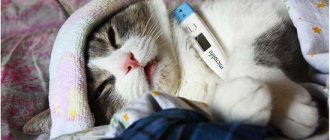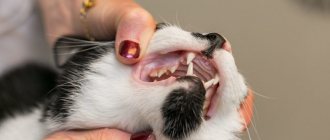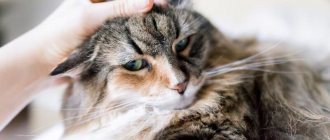When cats can shake
Cats can tremble not only in their sleep, but also while awake. The main problem for the owner is determining the cause of the trembling and whether any disease is present.
If this phenomenon occurs quite often, it is necessary to determine the room temperature. If the room temperature is not comfortable for the pet, measures should be taken to provide warmth to the pet. The measure consists of raising the room temperature or providing the animal with warm bedding and eliminating drafts.
It is necessary to provide cats with warm bedding.
Sign that the cat is freezing
A sign that your pet is freezing can be the “curl” position adopted during sleep and a deeply hidden nose.
The cat hides its nose if it is cold.
The cat is shaking as if she is cold: causes of tremor
When a cat suddenly starts to tremble, it alarms and sometimes even frightens the owners. This phenomenon is called tremor, it is caused by involuntary contraction of one or all muscle groups.
There are physiological and pathological reasons for its occurrence, which can only be accurately determined by a veterinary specialist.
But in order to provide timely help to the pet, the owner must know the reasons why the cat is trembling.
What is tremor in cats
Tremor in cats is a convulsive contraction of the muscles of the animal’s body, which is visually expressed in the form of small tremors. Sometimes the cat's whole body trembles, but certain parts of it may also shake.
Involuntary muscle contraction, called tremor, can also occur in a state of complete rest, indicating maximum relaxation of all muscle groups.
However, trembling often indicates that the cat has serious health problems and the animal requires urgent treatment.
Factors
- Another possible factor for tremors in a cat may be uncomfortable posture . Cat muscles and joints are capable of reacting this way to being in an uncomfortable position for a long time.
- An equally significant fact can be stress or previously experienced fear . A possible reason is the animal’s excessive activity during hunting and games. As well as the presence of injury or bruise.
The fact that a cat is trembling may be due to stress.
Situations that do not cause concern
Tremor is not always the cause of the disease. There are a number of reasons when this phenomenon does not cause much concern.
Cold
The most common factor that causes trembling in an animal's body is cold. No one is immune from hypothermia - and cats are no exception. If she is cold, she can tremble in different ways: large (this can be seen with the naked eye) or small (it is easy to notice the trembling by placing your palm on the pet’s body).
Cold tremor itself should not cause concern. However, remember that too low temperatures can make your cat sick. Therefore, you need to do everything possible to prevent her from getting hypothermic and shivering from this (heat the room well, use clothes for animals).
Emotional excitement
The cause of your pet's periodic trembling can be certain emotional states. For example, severe fear, discomfort from the appearance of strangers in the house, aggression. The tremor in this case is explained by the tension engulfing the cat. The animal is like a stretched string that is about to snap, and this is why it begins to tremble.
Not only negative emotions can cause this condition. A cat experiencing bliss may also tremble periodically. Many owners notice that when they return from work in the evening and a bored cat rushes towards them, rubs against their legs and purrs contentedly, it literally shakes with joy. This is fine. You should not leave your pet alone for a long time if she is experiencing separation so hard
Sex hormones
A very common reason for a cat to tremble is hormonal storms. They shock the animal's body when it needs mating. During such periods, the male frantically marks everything around him, screams heart-rendingly, demanding a bride, and suffers from a tremor that covers his entire body - from the ears to the tip of the tail.
The same goes for cats. During estrus, they also often tremble. It is better not to allow the animal to suffer in such a way. If kittens are not in your plans, sterilize your pet or at least buy pills that reduce libido.
"Sleepy" tremor
Sometimes owners notice that the cat trembles when it lies with its eyes closed. The tremor in this case is not constant. Rather, we can talk about periodic shuddering of the body or its individual parts (for example, paws).
Trembling as a warning sign
There are many different pathologies in which a cat trembles. The most common:
In search of an answer to the question of why a cat trembles like an aspen leaf, you should analyze all the factors and take a closer look at the pet. Are there other symptoms and, if so, what are they? Is the animal’s emotional state stable? does it want to “walk”; trembling occurs when the pet is sleeping or awake; etc.
All this is of great importance. If time passes and the situation does not normalize or there are accompanying alarming signs, the cat should be shown to a specialist as soon as possible.
An attentive owner of a mustachioed, striped, and perhaps completely hairless meowing pet (we are talking about) will definitely notice the changes that are happening to his animal. But how to react to them? Should you always bother your veterinarian? Or perhaps the symptoms that frighten us are not some kind of terrible pathology?
Today we invite you to talk about why a cat or cat may tremble, what diseases such trembling can be a symptom of, and how to help an animal in this situation
Pathologies
It is necessary to diagnose the pathology in time.
Tremor can accompany the development of pathologies, so owners should closely monitor their pet and seek advice from a specialist.
Possible pathologies:
- cat flu;
- panleukopenia;
- rhinotracheitis;
- calicivirus;
- central nervous system disorder;
- kidney damage.
It is necessary to diagnose a possible pathology in time and take all measures to eliminate it.
Associated symptoms
The red cat is trembling, why?
Let's take a closer look.
Subclinical form of panleukopenia
In the subclinical form of panleukopenia, the cat develops lethargy and fever.
- The subclinical form of panleukopenia often does not manifest itself with pronounced symptoms, so timely diagnosis is especially important.
- The latent period of this disease lasts about ten days, then lethargy and fever appear.
- The cat refuses food and water and is very thirsty.
- Vomiting, diarrhea, and bloating are possible.
Hidden period of rhinotracheitis
Apathy and loss of appetite appear in a cat with rhinotracheitis.
The latent period of rhinotracheitis lasts about a week.
- The first signs are apathy, loss of appetite, and fever.
- Serum nasal and eye discharge.
- Over time, they turn into purulent mucous discharge and increased salivation.
- Ulcers develop on the tongue, and parenchymal keratitis occurs.
Calcivirus infection
Calcivirus infection is dangerous and difficult to treat.
Calcivirus infection can be expressed by discharge from the eyes.
- In healthy and strong animals, it can occur in a latent form and manifest itself only as a slight tremor.
- However, when it develops into a chronic stage, it causes irreparable harm to the pet’s body.
- It can be expressed by slight discharge from the nose and eyes, lameness, apathy, and lethargy.
- A slight fluctuation in the body’s protective function and the disease becomes acute.
- The danger is the rapid course of the acute form and the development of secondary pathologies.
In this case, an unfavorable and cautious prognosis .
Puberty of a cat
One of the main reasons is puberty in the cat or the period of estrus.
One of the reasons for trembling is puberty in a cat.
If this is a young animal, such a condition causes unreasonable fear and, as a result, stress.
Central nervous system disorders
If during the daytime a pet tries to hide in a dark corner, this may indicate a disorder of the central nervous system and diseases such as meningitis, myelitis or neuroses of any nature.
With meningitis, depression will be present.
- With meningitis, depression, low blood pressure, and fever will be present. Severe, continuous vomiting may occur.
- Symptoms of myelitis may not appear immediately.
- The initial stage is characterized by constant attacks of anxiety.
- Then severe pain, aggression, and loss of coordination with partial paralysis occur.
- The animal is constantly trembling, there is hyperthermia, difficulty urinating and defecating.
- Neurosis manifests itself in the inappropriate behavior of an animal.
- This may be an unreasonable fear of familiar things and events - feeding, one’s own habitat, the owner.
- Fear of closed spaces or litter boxes.
- Aggressive behavior gives way to complete apathy.
- Prolonged licking of the fur until it is wet.
Symptomatic treatment
Physiological tremors do not require treatment. Such trembling does not cause severe discomfort to the cat. He does not lose his appetite, does not become lethargic, and his mood does not deteriorate. To help a cat, you need to keep it in microclimatic conditions that are comfortable for it, devote time to it, and then the pet will tremble only with joy.
Often people try to eliminate tremors with drugs that are intended for humans. For example, they give him strong sedatives and antispasmodics. Such self-medication is unacceptable! Firstly, the animal's condition can become much worse. Secondly, the clinical picture can be blurred if the tremors are caused by some kind of disease.
If the trembling does not go away and new symptoms appear, then the best solution is to show the cat to a veterinarian.
If the trembling recurs regularly or there are any other alarming signs, you should definitely show your pet to a doctor. He will prescribe competent treatment. In some cases, it is enough for the cat to minimize activity for a while and give a mild sedative, but serious therapy and even surgery may be required.
Whatever the cause of the tremor, the main thing for the breeder is to provide quality care. It is important to feed your cat a balanced diet, conduct a course of fortification every year, and carry out preventive cleaning of helminths every few months.
If the tremor is caused by hypothermia, the animal must be warmed. In case of stress and emotional turmoil, calm down with light sedatives - valerian and motherwort.











